Szondi Test ソンディ・テスト
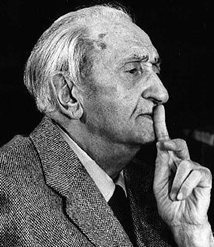
無意識の欲求や衝動を見出します
- ハンガリーの精神科医レオポルド・ソンディが考案した投影法検査。マニュアルと48枚の顔写真、テストシートで構成された人格診断検査です。精神疾患や心身症の病型診断、犯罪者の鑑別診断に大変有効です。また、一般的なカウンセリングなどあらゆる臨床場面での活用も可能です。
| それぞれ下の一組8枚の写真の中から最も好きな顔の写真と嫌いな顔の写真をそれぞれ2枚選びます。対応する番号のボタンを一度ずつ押してください。6組繰り返しましたら最後に診断ボタンを押してください。あなたのタイプが出ます。
|
Find unconscious desires and urges
Projection test devised by Hungarian psychiatrist Leopold Szondi. It is a personality diagnostic test consisting of a manual, 48 facial photographs, and a test sheet. It is very effective for type diagnosis of mental illness and psychosomatic disorder, and differential diagnosis of criminals. It can also be used in all clinical situations such as general counseling.
From each of the 8 photos in the set below, select 2 photos of your favorite face and 2 photos of your disliked face. Press the button with the corresponding number once. After repeating 6 sets, please press the diagnostic button at the end. Your type will come out.
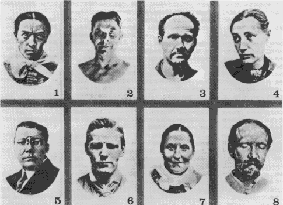
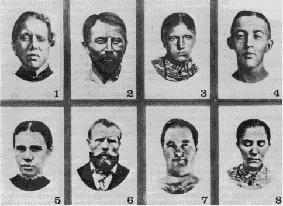
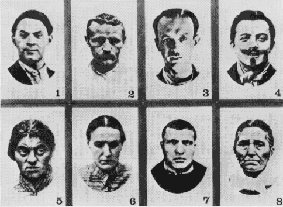
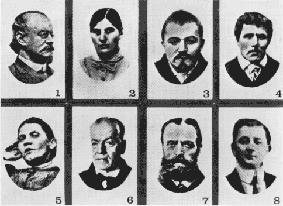
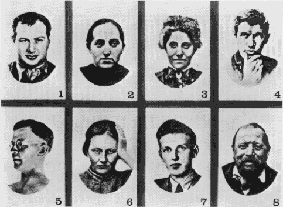
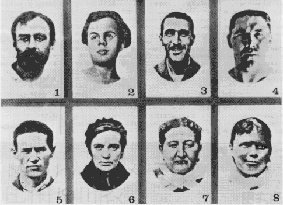
Szondi Test ソンディ・テスト
ソンディ・テストの全貌 富樫 橋
およそあらゆる心理テストは、「人間の心の状態を測定する道具」であると定義することができる。それならば、測定しようとする「心の状態」は、テスト製作者の意図によって種々異なってくるのは当然である。つまり、テスト製作者が関心を抱き、測定しようと欲する心の状態というものは、彼の考えの基礎にある「心の構造」の内容によって全く異なってくるのである。
それゆえ、現在、いろいろな心理テストが存在し、使用されているが、それらのテストが測定しようとするものの内容の違いは、製作者が個人的に依って立つ「心の構造の概念」、すなわち「心理学」ないし「思想」の違いから生まれてくるのである。しかし、いかなる理由からか、この「依拠心理学」ないし「依拠している思想」を明確に表明したテストは極めて少なく、あっても極めて曖昧である。1)筆者がなぜこの点を強調するかと言うと、思想のないところに構造は生まれず、構造のないところには測定すべき確固とした物差しも生まれないと思うからである。したがって、思想なき心理テスト、心理学に基づかない心理テストは文学に過ぎない。したがって、思想なき心理テスト、心理学に基づかない心理テストは、文学に過ぎない。
また、ほとんど全ての心理テストは、それぞれ独自に考案された「刺激材料」を設定している。そして、その刺激材料を被検者に示して得られた反応「一次情報(言語,数値,記号など)」を、製作者が考えた「心の構造」に合わせて「二次情報(言語など)」に翻訳する。その後でそれを解釈し、製作者が推定しようとする「心の状態」を、説明・診断するための「判定情報」に変換するという構造をもっている。
このような心理テストにおける、テスト結果の解釈・判定体系について、利用者が注意すべき重要な点は、「刺激→反応の因果的直接性」と、得られた結果の「解釈の単純性」である。なぜなら、前者は、間接性の要素が混じる程、後者は、複雑さが増える程、客観性が希薄になるからである。客観的でないものは科学的ではなく、普遍性がない。普遍的でないものは、多くの心理学徒の共通概念・共通言語の一部として利用することができない。
したがって、我々はどんな心理テストでも、この因果的直接性と解釈単純性の水準を、「テストの妥当性」とともに考慮しておく必要があると考える。
さらに、測定の対象である「心」は、瞑想のような特別な状態にある場合を除き、常に絶え間なく流動し、決して固定することはない。それゆえ、全ての1回法テストは、原理的に、「風邪をひいた受験生の失敗」と同じく、普段の精神状態とは異なるテスト結果を示す可能性が強いのである。とくに何らかの緊張状態があるとき、被検者の常ならぬ心の状態を一般化し固定化して理解してしまう危険性がある、ということに留意すべきである。要するに全ての1回法テストは、人間の精神や魂を測定しようとするにはふさわしくないのである。
次は、「意識テスト」と「無意識テスト」の違いの問題である。あるテストが、刺激にたいする被検者の意識領域の反応を予想したものであれば、それは単なる意識テストである。それに対して、特別な無意識の領域の反応を得るために、材料や方法が吟味されたものは、無意識テストと呼ばれる。
ここで、無意識の内容を把握するテストとして知られている、代表的な二つのテストを比較しておこう。
代表的な無意識テストの比較 ======================================================================== Test 刺激材料 依拠心理学 1次情報 2次情報 3次情報 4次情報 方 法 ======================================================================== Rorschach インクの 知覚心理学? 言語 言語の 記号 心理的 Test 染み ( ? ) 意味を 解釈? (1回法) 印象の表現 解釈 ------------------------------------------------------------------------ Szondi 衝動病 衝動心理学 記号 衝動病理 -- -- Test 患者の顔 ソンディ 学的解釈 (10回法) 好き嫌い選択 ------------------------------------------------------------------------ソンディ・テストは、個人的無意識、集合的無意識、遺伝する家族的無意識の、全ての無意識の領域の反応を、「衝動心理学」という特別な心理学理論に基づいて明確に意識し、意図して作られた。それは、極めて「因果的直接性・解釈単純性」に優れた10回法のテストであることが上表から読みとれるであろう。ソンディ・テストは、言葉による陳述を求めないので、いきなりロールシャッハの4次情報に相当するものが、2段階で得られるのである。
Szondi Test Szondi Test
The whole picture of the Szondi test
Togashi Bridge
Almost any psychological test can be defined as a “tool for measuring the state of the human mind.” In that case, it is natural that the “state of mind” to be measured varies depending on the intention of the test maker. In other words, the state of mind that the tester is interested in and wants to measure depends entirely on the content of the “structure of the mind” that underlies his ideas.
Therefore, various psychological tests currently exist and are used, but the difference in the content of what they try to measure is the “concept of the structure of the mind” on which the creator personally stands. In other words, it is born from the difference between “psychology” and “idea.” However, for whatever reason, there are very few tests that clearly state this “reliant psychology” or “reliant thought”, and even if they are, they are extremely vague. 1) The reason why the author emphasizes this point is that no structure is created where there is no idea, and no solid measuring rod to be measured is created where there is no structure. Therefore, psychological tests without thought and psychological tests that are not based on psychology are nothing more than literature. Therefore, psychological tests without thought and psychological tests that are not based on psychology are nothing more than literature.
In addition, almost all psychological tests set their own “stimulating materials”. Then, the reaction “primary information (language, numerical value, symbol, etc.)” obtained by showing the stimulating material to the subject is matched with the “mental structure” considered by the creator, and “secondary information (language, etc.)” ) ”. After that, it has a structure that interprets it and converts the “state of mind” that the producer tries to estimate into “judgment information” for explanation and diagnosis.
Regarding the interpretation / judgment system of test results in such psychological tests, the important points that users should pay attention to are “causal directness of stimulus-> reaction” and “simplicity of interpretation” of the obtained results. Is. This is because the former becomes less objective as the elements of indirectness are mixed, and the latter becomes more complex. What is not objective is not scientific and has no universality. Those that are not universal cannot be used as part of the common concept / language of many psychologists.
Therefore, we believe that in any psychological test, this level of causal directness and interpretation simplicity needs to be considered along with “test validity”.
Moreover, the “mind” to be measured is constantly flowing and never fixed, except in special conditions such as meditation. Therefore, in principle, all one-time tests are likely to show test results that are different from the usual mental state, similar to “failure of a student who has a cold”. It should be noted that there is a risk of generalizing, immobilizing and understanding the subject’s unusual state of mind, especially when there is some tension. In short, all one-time tests are not suitable for trying to measure the human mind or soul.
Next is the question of the difference between the “consciousness test” and the “unconsciousness test”. If a test predicts the subject’s area of consciousness response to stimuli, it is just a consciousness test. On the other hand, a test in which materials and methods are examined in order to obtain a reaction in a special unconscious area is called an unconscious test.
Here, let’s compare two typical tests known as tests for grasping the unconscious content.
Comparison of typical unconscious tests
================================================== ======================
Test Stimulation material Reliance psychology Primary information Secondary information Tertiary information Fourth information
Method
================================================== ======================
Rorschach Ink Perceptual Psychology? Language language symbol psychological
Test Stain (?) Interpret the meaning?
(One-time method) Expression and interpretation of impression
————————————————– ———————-
Szondi Impulsivity Impulsivity Psychology Symbol Impulsivity Pathology ----
Test Patient’s face Sondy interpretation
(10 times method) Like / dislike selection
————————————————– ———————-
The Sondy Test clearly recognizes and intends the reactions of all unconscious areas, personal unconscious, collective unconscious, and inherited family unconscious, based on a special psychological theory called “impulsive psychology.” Was made. It can be seen from the above table that it is a 10-step test with extremely excellent “causal directness / interpretation simplicity”. Since the Szondi test does not require a verbal statement, the equivalent of Rorschach’s quaternary information is suddenly obtained in two steps.
